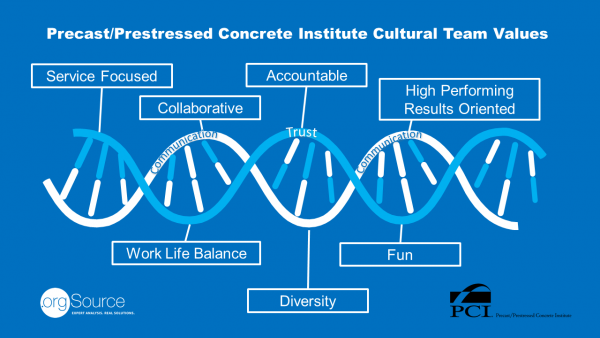When Culture is a Skill Set Leaders Reap Rewards—PCI Lives Their Values

What makes for a memorable social event? A case of lite beer, a bag of Bugles, and a bunch of people who don’t know each other won’t be anyone’s Instagram moment. Careful planning is the secret to providing a terrific experience.
Organizations that treat culture like an impromptu party will see their “guests” leave early. Culture revolves around personalities and a positive environment depends on understanding the needs of individual players and their interaction as a team.
Because relationships are invisible, they are easier to ignore than obvious business indicators. I’m glad to see more organizations approaching group dynamics as an essential component of outstanding performance. Associations that treat culture as a skill set are reaping rewards from their investment.
The Precast/Prestressed Concrete Institute (PCI) is an example of what can be accomplished when leaders engage everyone on the team in building a workplace characterized by collective well-being and respect.
On a recent Association 4.0 Podcast, .orgSource Senior Consultant, Kevin Martlage, interviewed PCI staffers, Beth Taylor and Randy Wilson about that experience. Beth is the Chief Financial and Administrative Officer at PCI and Randy is Director, Architectural Precast Services.
“Over the past three years, .orgSource has been working with the PCI team on several significant projects,” Kevin said. “Helping the group become skilled culture builders is one of the most rewarding experiences I’ve been privileged to support.
“This initiative has impacted the organization in numerous ways. But the core benefits are:
- Defining the key traits the team sees as most important.
- Developing an agreed-upon language to describe those qualities.
- Using those ideals to identify PCI’s cultural DNA and supporting that understanding through visibility across the organization.”
Begin With Yourself
Beth and Randy are committed to making PCI a great place to work. Beth described her feelings this way.
“In my role, I oversee departments that interact with employees throughout the organization. The willingness to treat your colleagues with respect and the ability to collaborate creates a healthy environment. Having fun is one tenant we identified as part of our organizational DNA. These are the other six qualities:

- Service
- Collaboration
- Accountability
- High-performing and results-oriented
- Diversity
- Work/life balance
“Promoting these values makes our office a space people enjoy. And colleagues who like working together have a good time at work. That satisfaction is important to me.
“Before we started this journey, PCI participated in the National Manufacturers Association Employee Satisfaction Survey. Our results were not where we wanted them to be. The leadership team began by discussing the issues. Realizing we could benefit from outside counsel, we started working with Kevin and Sharon Rice, .orgSource, Managing Director of Business Strategy.
Forget the Finish Line
“The DNA document that we created identified the values we aspire to. We believe these are the qualities that support a healthy office environment. As our consciousness expanded, we realized that the leadership team needed to model the behavior we were seeking to promote. If we wanted to change our group dynamics, we had to live the example.
“Our exploration has been going on for almost four years. We would have moved faster without the pandemic,” Beth notes. “But we realize that building culture isn’t a project with a finish line. It is a work in progress.”
I agree. Culture is organic. Behavior and attitudes evolve over time. But PCI and Kevin have made impressive strides together. I was especially interested to learn that the PCI team is passing their expertise along to members. Randy is creating a webinar series for manufacturing plant leaders to use to improve relationships and collaboration in their facilities.
Share Expertise
Culture gets short shrift across the business landscape. This may be one area where nonprofits are ahead of the curve. Often, leaders aren’t willing

to devote resources, either human or financial, to initiatives that won’t directly impact the bottom line. This type of learning program is an incredible membership benefit. It’s a value that many associations could consider replicating for their constituents. Randy provided an overview of the initiative.
“Precast concrete production facilities have anywhere from 50 to 500 workers. They may be single or multiple plants. We also wanted to include the associate members who work in an administrative capacity. The program is tailored for a broad-based audience.
“In a nutshell, the dominant themes are consistency and alignment. Managers can easily apply those concepts to how they make decisions and interact with employees. When your actions are predictable and support the organization’s vision and mission, then you build trust. That is the foundation for all cultural initiatives. If your team believes that you are dependable and that you have their backs, they will buy into your ideas.
Evaluate Alignment
“Maintaining a consistent relationship between mission, vision, and customers is critical for a successful company,” Randy advised. “We talk about the “shiny penny syndrome” or the attraction of ideas simply because they are innovative or new.
“It’s great to have a variety of options. When an employee or a customer suggests an opportunity for improvement by all means consider the recommendation. But base your decision on identifying the ideas that advance the organization’s mission and vision. People will respect that objectivity.
“Making that evaluation requires collaboration. That’s another quality that is essential for a successful culture. You need to understand how to get the right mix of thinking and ideas to solve your problems efficiently. After you have buy-in from your team, communicate their enthusiasm and commitment across the organization.
“As the project moves from concept to reality, everyone should be accountable for their roles and responsibilities. Those are ideas that are part of the series and the main concepts for what a good plant culture looks like.”
“The idea of alignment extends to relationships among team members,” Kevin advised. “Effective culture builders understand group dynamics. They know how people prefer to communicate and work together and they respect those styles. Of course, the goal is not just accommodating work habits. Identifying where individual talents lie and utilizing the team’s skills helps people to collaborate effectively.”
Check-In With Reality
“Another type of alignment we discuss in the series is self-reflection,” Randy said. “Does your perception of the situation align with reality? We all have times when we question our actions or behavior. It’s important to have someone you can turn to for an honest assessment. Everyone, whether they are the CEO or the most junior employee, benefits from constructive feedback.”
“We see the results of this awareness throughout the organization,” Beth observed. “When I came to PCI six years ago, the interaction among the board, staff, and members was not as collegial. Today folks are collaborating to solve problems. That has significantly increased the level of trust for everyone. At a recent meeting, the board congratulated us on being the best staff ever!”
Those kudos reflect a significant accomplishment. When there is mutual respect among the board, staff, and members, culture becomes the exact opposite of that impromptu party. It centers around treating people with deliberate hospitality. Careful planning ensures that the workplace reflects that concern for employee well-being and success.
When you follow PCI’s example and make culture a skill set, you’ll be rewarded with trust, accountability, collaboration, and teams that produce outstanding results.

